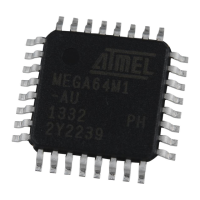40
7647H–AVR–03/12
Atmel ATmega16/32/64/M1/C1
6. Power Management and Sleep Modes
Sleep modes enable the application to shut down unused modules in the MCU, thereby saving
power. The AVR provides various sleep modes allowing the user to tailor the power consump-
tion to the application’s requirements.
To enter any of the five sleep modes, the SE bit in SMCR must be written to logic one and a
SLEEP instruction must be executed. The SM2, SM1, and SM0 bits in the SMCR Register select
which sleep mode (Idle, ADC Noise Reduction, Power-down, Power-save, or Standby) will be
activated by the SLEEP instruction. See Table 6-1 for a summary. If an enabled interrupt occurs
while the MCU is in a sleep mode, the MCU wakes up. The MCU is then halted for four cycles in
addition to the start-up time, executes the interrupt routine, and resumes execution from the
instruction following SLEEP. The contents of the register file and SRAM are unaltered when the
device wakes up from sleep. If a reset occurs during sleep mode, the MCU wakes up and exe-
cutes from the Reset Vector.
Figure 5-1 on page 29 presents the different clock systems in the ATmega16/32/64/M1/C1, and
their distribution. The figure is helpful in selecting an appropriate sleep mode.
6.1 Sleep Mode Control Register
6.1.1 Sleep Mode Control Register – SMCR
The Sleep Mode Control Register contains control bits for power management.
• Bits 3..1 – SM2..0: Sleep Mode Select Bits 2, 1, and 0
These bits select between the five available sleep modes as shown in Table 6-1.
Note: 1. Standby mode is only recommended for use with external crystals or resonators.
• Bit 1 – SE: Sleep Enable
The SE bit must be written to logic one to make the MCU enter the sleep mode when the SLEEP
instruction is executed. To avoid the MCU entering the sleep mode unless it is the programmer’s
purpose, it is recommended to write the Sleep Enable (SE) bit to one just before the execution of
the SLEEP instruction and to clear it immediately after waking up.
Bit 76543210
– – – – SM2 SM1 SM0 SE SMCR
Read/Write R R R R R/W R/W R/W R/W
Initial Value 00000000
Table 6-1. Sleep Mode Select
SM2 SM1 SM0 Sleep Mode
000Idle
0 0 1 ADC Noise Reduction
010Power-down
011Reserved
100Reserved
101Reserved
110Standby
(1)
111Reserved

